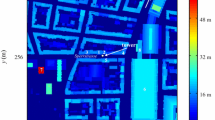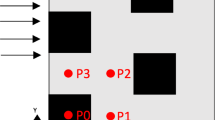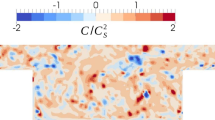Abstract
Within the roughness sublayer (RSL) of dense urban canopies composed of uniformly distributed cuboids, the time and planar-averaged mean velocity profile exhibits an approximate exponential shape characterized by a depth-independent attenuation coefficient a. A formulation that links a to the zero-plane displacement d and aerodynamic roughness length \(z_{\mathrm{om}}\) is proposed using a one-dimensional momentum balance between the background mean horizontal pressure gradient, vertical gradients of total stresses, and the drag force. Dispersive effects on a within the urban RSL are then explored using large-eddy simulations (LESs) that vary independently the planar (\(\lambda _{\mathrm{p}}\)) and frontal (\(\lambda _{\mathrm{f}}\)) densities of the cuboids. The LES results are used to compute d and \(z_{\mathrm{om}}\) by fitting a log-profile to the mean velocity above the canopy. Within the canopy, the LES results are also used to estimate (i) a by fitting an exponential profile to the computed time and planar-averaged velocity, (ii) profiles of drag coefficients, and (iii) turbulent as well as dispersive stresses. The LES results demonstrate that dispersive stresses can be commensurate with turbulent stresses in magnitude and act in the same direction. Moreover, dispersive transport, determined from vertical gradients of dispersive stresses, is some 25–75% of turbulent stress gradients. These dispersive effects impact a (and thus d and \(z_{\mathrm{om}}\)) via two mechanisms: (i) reducing the effective adjustment length scale that leads to an increase in a and (ii) increasing the effective mixing length that leads to a reduction in a across a wide range of \(\lambda _{\mathrm{f}}\) and \(\lambda _{\mathrm{p}}\). These two effects are shown to be partly compensatory giving rise to an apparent constant a with respect to height inside the canopy. The effects of mean recirculation and the usage of the drag force centroid method to estimate d are discussed. The analysis also evaluates the consequences of a finite roughness sublayer thickness extending above the canopy on the derived expressions.


















Similar content being viewed by others
References
Belcher S, Jerram N, Hunt J (2003) Adjustment of a turbulent boundary layer to a canopy of roughness elements. J Fluid Mech 488:369–398
Blunn LP, Coceal O, Nazarian N, Barlow JF, Plant RS, Bohnenstengel SI, Lean HW (2022) Turbulence Characteristics Across a Range of Idealized Urban Canopy Geometries. Boundary-Layer Meteorol 182:275–307. https://doi.org/10.1007/s10546-021-00658-6
Böhm M, Finnigan JJ, Raupach MR, Hughes D (2013) Turbulence structure within and above a canopy of bluff elements. Boundary-Layer Meteorol 146(3):393–419
Britter R, Hanna S (2003) Flow and dispersion in urban areas. Annu Rev Fluid Mech 35(1):469–496
Castro IP (2017) Are urban-canopy velocity profiles exponential. Boundary-Layer Meteorol 164(3):337–351
Cheng H, Castro IP (2002) Near wall flow over urban-like roughness. Boundary-Layer Meteorol 104(2):229–259
Christen A, Rotach MW, Vogt R (2009) The budget of turbulent kinetic energy in the urban roughness sublayer. Boundary-Layer Meteorol 131(2):193–222
Coceal O, Belcher S (2004) A canopy model of mean winds through urban areas. Q J R Meteorol Soc 130(599):1349–1372
Coceal O, Thomas TG, Castro IP, Belcher SE (2006) Mean flow and turbulence statistics over groups of urban-like cubical obstacles. Boundary-Layer Meteorol 121(3):491–519
Fernando HJ, Zajic D, Di Sabatino S, Dimitrova R, Hedquist B, Dallman A (2010) Flow, turbulence, and pollutant dispersion in urban atmospheres. Phys Fluids 22(5):051301
Finnigan J (2000) Turbulence in plant canopies. Annu Rev Fluid Mech 32(1):519
Finnigan J, Belcher S (2004) Flow over a hill covered with a plant canopy. Q J R Meteorol Soc 130(596):1–29
Giometto M, Christen A, Meneveau C, Fang J, Krafczyk M, Parlange M (2016) Spatial characteristics of roughness sublayer mean flow and turbulence over a realistic urban surface. Boundary-Layer Meteorol 160(3):425–452
Grimmond C (2006) Progress in measuring and observing the urban atmosphere. Theor Appl Climatol 84(1):3–22
Grimmond C, Oke TR (1999) Aerodynamic properties of urban areas derived from analysis of surface form. J Appl Meteorol 38(9):1262–1292
Inoue E (1963) On the turbulent structure of airflow within. J Meteorol Soc Jpn 41(6):317–326
Jackson PS (1981) On the displacement height in the logarithmic velocity profile. J Fluid Mech 111(-1):15
Juang JY, Katul GG, Siqueira MB, Stoy PC, McCarthy HR (2008) Investigating a hierarchy of Eulerian closure models for scalar transfer inside forested canopies. Boundary-Layer Meteorol 128(1):1–32
Kanda M, Moriwaki R, Kasamatsu F (2004) Large-eddy simulation of turbulent organized structures within and above explicitly resolved cube arrays. Boundary-Layer Meteorol 112(2):343–368
Kanda M, Inagaki A, Miyamoto T, Gryschka M, Raasch S (2013) A new aerodynamic parametrization for real urban surfaces. Boundary-Layer Meteorol 148(2):357–377
Katul GG, Mahrt L, Poggi D, Sanz C (2004) One-and two-equation models for canopy turbulence. Bound-Layer Meteorol 113(1):81–109
Leonardi S, Castro IP (2010) Channel flow over large cube roughness: a direct numerical simulation study. J Fluid Mech 651:519–539
Leonardi S, Orlandi P, Djenidi L, Antonia RA (2015) Heat transfer in a turbulent channel flow with square bars or circular rods on one wall. J Fluid Mech 776:512–530
Li Q, Bou-Zeid E (2019) Contrasts between momentum and scalar transport over very rough surfaces. J Fluid Mech 880:32–58
Li Q, Bou-Zeid E, Anderson W (2016) The impact and treatment of the Gibbs phenomenon in immersed boundary method simulations of momentum and scalar transport. J Comput Phys 310:237–251
Li Q, Bou-Zeid E, Grimmond S, Zilitinkevich S, Katul G (2020) Revisiting the relation between momentum and scalar roughness lengths of urban surfaces. Q J R Meteorol Soc 146(732):3144–3164
Li Q, Yang J, Yang L (2021) Impact of urban roughness representation on regional hydrometeorology: an idealized study. J Geophys Res Atmos 126(4):e2020JD033812
Macdonald RW, Griffiths RF, Hall DJ (1998) An improved method for the estimation of surface roughness of obstacle arrays. Atmos Environ 32(11):1857–1864
Martilli A, Clappier A, Rotach MW (2002) An urban surface exchange parameterisation for mesoscale models. Boundary-Layer Meteorol 104(2):261–304
Moriwaki R, Kanda M (2006) Local and global similarity in turbulent transfer of heat, water vapour, and CO\(_{2}\) in the dynamic convective sublayer over a suburban area. Boundary-Layer Meteorol 120(1):163–179
Nazarian N, Krayenhoff ES, Martilli A (2020) A one-dimensional model of turbulent flow through “urban’’ canopies (mlucm v2. 0): updates based on large-eddy simulation. Geosci Model Dev 13(3):937–953
Nepf HM, Vivoni E (2000) Flow structure in depth-limited, vegetated flow. J Geophys Res Oceans 105(C12):28547–28557
Poggi D, Katul GG (2008) The effect of canopy roughness density on the constitutive components of the dispersive stresses. Exp Fluids 45(1):111–121
Poggi D, Katul G, Albertson J (2004) Momentum transfer and turbulent kinetic energy budgets within a dense model canopy. Boundary-Layer Meteorol 111(3):589–614
Poggi D, Katul G, Albertson J (2004) A note on the contribution of dispersive fluxes to momentum transfer within canopies. Boundary-Layer Meteorol 111(3):615–621
Poggi D, Porporato A, Ridolfi L, Albertson J, Katul G (2004) The effect of vegetation density on canopy sub-layer turbulence. Boundary-Layer Meteorol 111(3):565–587
Poggi D, Krug C, Katul GG (2009) Hydraulic resistance of submerged rigid vegetation derived from first-order closure models. Water Resour Res 45:W10442
Pope SB (2000) Turbulent flows. Cambridge University Press, Cambridge
Raupach MR (1981) Conditional statistics of Reynolds stress in rough-wall and smooth-wall turbulent boundary layers. J Fluid Mech 108(-1):363–382
Raupach MR, Finnigan JJ, Brunei Y (1996) Coherent eddies and turbulence in vegetation canopies: the mixing-layer analogy. Boundary-Layer Meteorol 78(3–4):351–382
Rotach MW (1999) On the influence of the urban roughness sublayer on turbulence and dispersion. Atmos Environ 33(24–25):4001–4008
Schmid MF, Lawrence GA, Parlange MB, Giometto MG (2019) Volume averaging for urban canopies. Boundary-Layer Meteorol 173(3):349–372
Xu H, Altland S, Yang X, Kunz R (2021) Flow over closely packed cubical roughness. J Fluid Mech 920:A37. https://doi.org/10.1017/jfm.2021.456
Yang XIA, Sadique J, Mittal R, Meneveau C (2016) Exponential roughness layer and analytical model for turbulent boundary layer flow over rectangular-prism roughness elements. J Fluid Mech 789:127
Yoshida T, Takemi T, Horiguchi M (2018) Large-eddy-simulation study of the effects of building-height variability on turbulent flows over an actual urban area. Boundary-Layer Meteorol 168(1):127–153
Acknowledgements
The datasets generated during and/or analysed during the current study are available from the corresponding author on reasonable request. QL acknowledges support from the US National Science Foundation (NSF-CAREER-2143664, NSF-AGS-2028633, NSF-CBET-2028842) and computational resources from the National Center for Atmospheric Research (UCOR-0049). GK acknowledges support from the US National Science Foundation (NSF-AGS-2028633) and the Department of Energy (DE-SC0022072). The authors thank four anonymous reviewers for their helpful suggestions that help to improve the paper.
Author information
Authors and Affiliations
Corresponding author
Additional information
Publisher's Note
Springer Nature remains neutral with regard to jurisdictional claims in published maps and institutional affiliations.
Rights and permissions
About this article
Cite this article
Li, Q., Katul, G. Bridging the Urban Canopy Sublayer to Aerodynamic Parameters of the Atmospheric Surface Layer. Boundary-Layer Meteorol 185, 35–61 (2022). https://doi.org/10.1007/s10546-022-00723-8
Received:
Accepted:
Published:
Issue Date:
DOI: https://doi.org/10.1007/s10546-022-00723-8




